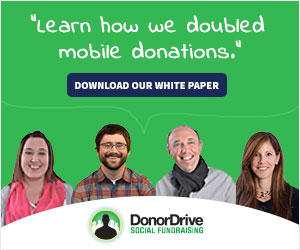image: play.google.com
There has been a lot of fanfare surrounding Monday’s news that Facebook has rolled out a button for nonprofits to use to enable donations on their page. Facebook brings glitz, excitement, and social media to the nonprofit sector.
I launched this site to help provide resources for nonprofits that will enable them to strengthen the sector. So, I’m happy to celebrate any increase in giving and sustainability as it relates to the sector. I’m happy that Facebook has reflected some of its star-power in the direction of the nonprofit sector. Increased awareness is good for all!
WIIFM?
But, I’m also a cynic. I’m not jumping on any bandwagon just because it has a Facebook banner. I want to know how it’s going to help nonprofits. What’s in it for me? (WIIFM) And from what I can see so far, it doesn’t offer anything more to help. It does, however, provide Facebook with some useful personal information. As it is today, anyone can include a link on their group’s Facebook page announcing an annual appeal or a way to donate, which would bring the fan to the organization’s website.
Website, Sweet Website
You know, your website—the masterpiece (or work in progress) that you’ve spent plenty of money and wo/man hours perfecting. The website that includes your group’s story, information about your mission and board, and the cause your group serves. Your site (should) render appropriately on any device: tablet, desktop, smartphone (watch? I’m not sure about that one yet) and provide an excellent user experience.
Your website that (should) feature a clearly labeled DONATE button-and enables one to give to your cause. It also (should) input information about that person who just donated-and became a champion of your cause- into your donor management system. This allows your group to welcome that champion into the fold. To say “thank you” and “here’s what your generous contribution will help us accomplish.” And to continue the relationship to see if there are additional ways to interact.
It allows your group to stay in contact and develop a relationship with that new donor. In the for-profit world, we’d call it “lead nurturing”-and I can’t think of any for-profit that would take a $20 sale and put a new customer lead in the hands of a third party.
From what I see, the only thing that an organization will get from the Facebook button is a donation. A blind, anonymous donation. No way to follow up. No way to say thank you. If you think the number of first time donors leaving your cause is high…imagine the impact that this would have.
Consider this Scenario
Suzy Smith has 389 Facebook friends and visits WeSaveYellowFinches.org’s Facebook page. She’s in a generous mood today and clicks on the Donate button. Facebook uses her credit card info and processes the transaction, sending 100% of the $20 donation your way. You have no idea if it came from Suzy, Jim, Johnny. You don’t know if the donor has visited your site. You don’t know anything more than you received $20. Suzy may or may not share her donation news with her friends. You have no real way of asking her, personally, to tell others about your cause. Sometime in the future one of her 389 friends, posts something about your group and she replies:” Yeah, I know that group…I donated $20 last year and never heard anything from them.”
On the other hand, Facebook is great for leveraging positive peer power. Wouldn’t it be better if she shared one of your group’s posts about what you’re raising funds for with those 389 friends?
To that end, Facebook is really useful! You see, the folks at Facebook just acknowledged that the average post only reaches 15% of your fans organically-and the way to “boost” that post is to sponsor it. There is a movement asking Facebook to create real support for nonprofits by creating an advertising grant (similar to Google’s).
And, personally, I would take a grant over a button any day. But then again, I’d prefer to know who my donors are, too.
Sign the Petition for a Facebook Ad Grant-use #facebookadgrants on the Twitter machine.
Please go to Change.org’s site and sign the petition click here and ask your peers to do the same!




